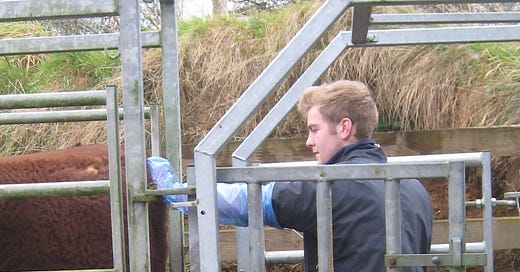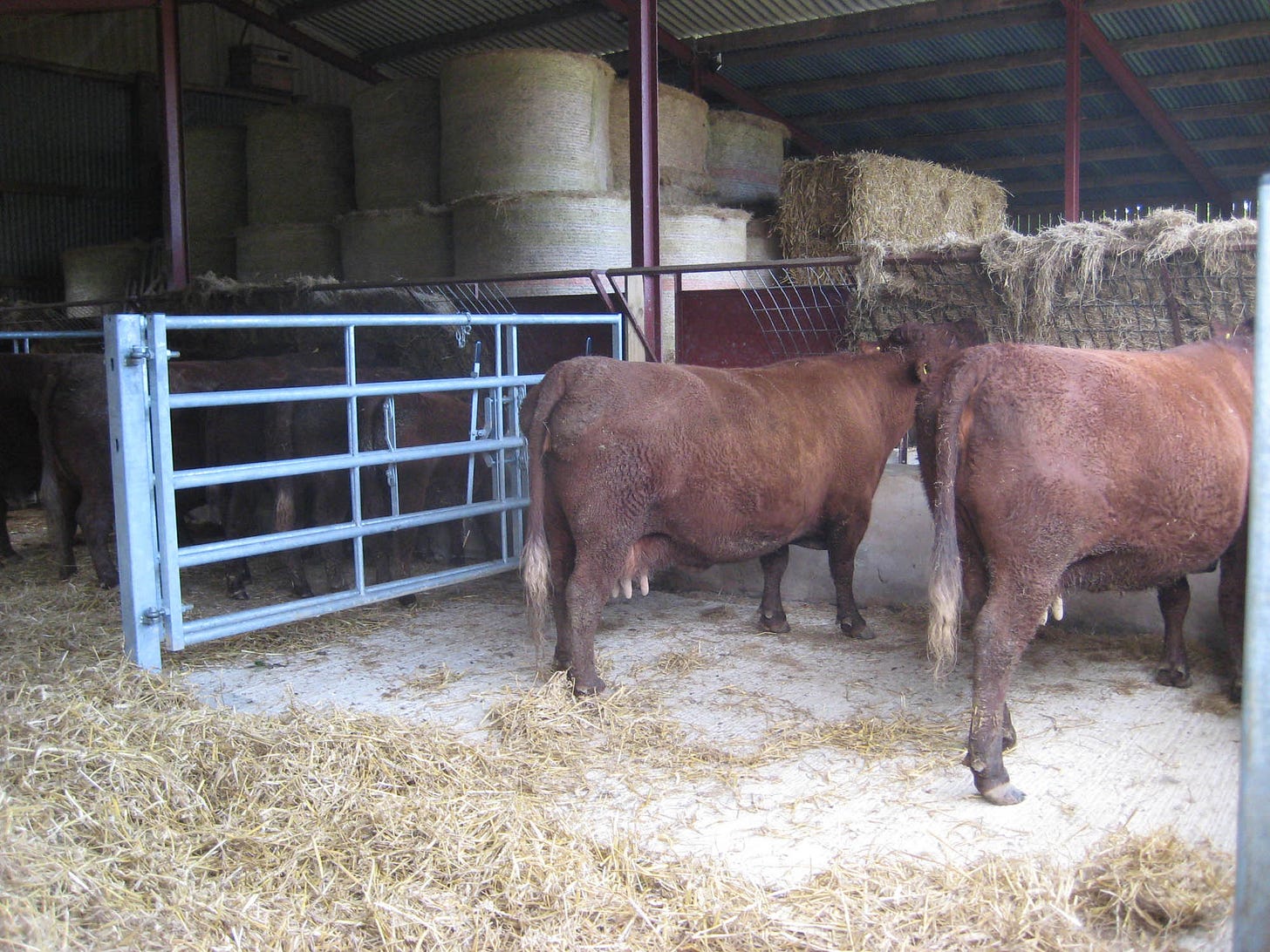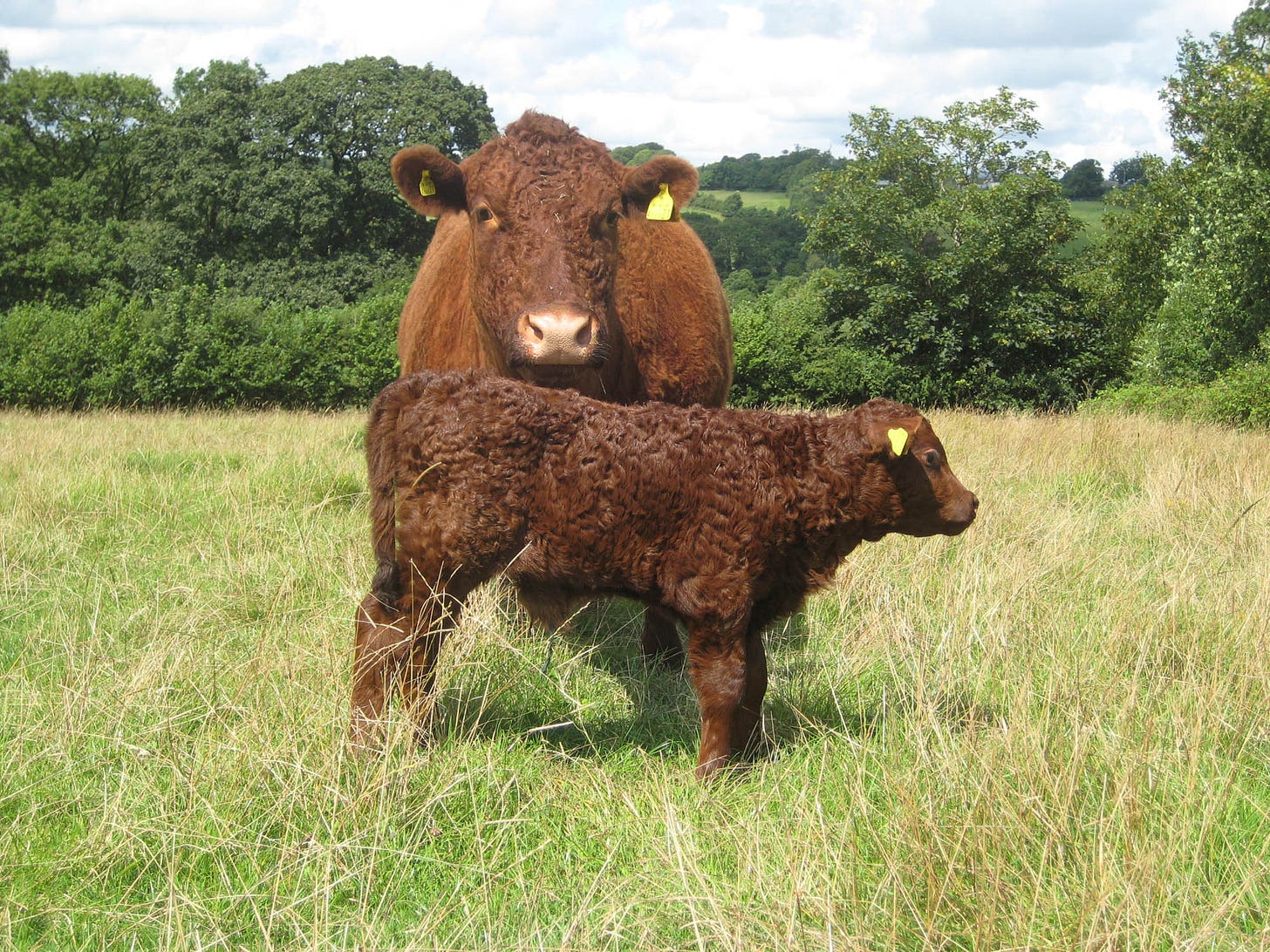It’s a week for stress. It’s the week I’m guaranteed at least one night of wakefulness and fear. It’s the week our cows are tested for bovine tuberculosis (bTB/TB). The vet will take his pair of injection guns, those revolvers of fear, and inject one jab of avian and one jab of bovine tuberculin in each neck. We take advantage of the vet being here and get him to do pregnancy diagnoses of any cows that haven’t yet been confirmed as in calf.
Day one and the cows and calves are put through the cattle race. Each one has two tufts of winter coat clipped from their necks, their skin thicknesses measured with callipers, noted in millimetres on a clip board that swings from the crush on a piece of thick baler twine. Chris the vet is thorough, relaxed, apparently casual, while I am in knots even though we will know nothing until three days have passed. There’s a large, lipped shelf to hold all the paraphernalia – the bucket we had hanging from a rail was enough for most cattle crush sessions, but not for this annual process. Chris checks the developing calves inside the cows in late pregnancy, and confirms that Noilly, the youngest of the heifer group, is also in calf, due in mid-September, four months after the others because of her age.
Day two, three days later, the manic drumming of the woodpecker in the large oak nearest to the house greets us; my heart is beating just as fast. Chris wipes his hand across the necks of the heifers, steers and calves – there are no raised bumps; they are clear. Chris is now focussed on the cows as we move them through the race. He is already using his pregnancy scanner, but I can’t think about anything other than the TB test. “Are they clear?” I ask. “Yes, yes”, he says. I close my eyes and the sick lump in my gut gets a little smaller.
Willow is a problem cow; her ovaries are borderline cystic and so has an unwieldy bulling pattern, often impossible to detect and in order to get her in calf we have to treat her with hormones over a week in order to stimulate her cycle in readiness for AI. If we didn’t do this she’d have to be culled, and it’s costly and time consuming, but she is a lovely cow and produces great calves, so we persevere. So far she’s taken to the AI immediately, following treatment. Chris plunges into her depths and then hands me his scanning glasses so I can see what’s happening inside. In a black circle of liquid is an eight-week-old foetus, on its back, legs in the air. Willow is in calf.
Harriet and Oscar
Harriet is next and last. Lovely twelve-year-old Harriet, with the light ginger heavily curled coat, arthritic of hip, gentle, delighted with her last unexpected calf Oscar who is thriving on her milk. Harriet, who we had given one very last chance to get into calf. Chris dips inside, but there is no new life growing there, and she has a luteal cyst. Harriet will rear Oscar, have spring and summer out to grass, and then we will have to say our goodbyes. When we brought her home with her calf Quinevere, everyone thought she would rear her particularly charming wee heifer and then that would be it, but we nurtured her and she has her Oscar, and in turn Quinevere is in calf for the first time. Harriet will have had three unexpected extra years with us. And most critically, our herd is clear of TB. I could cry with relief.
If you want to keep cattle you must face the spectre of bovine tuberculosis and decide if you have the stomach for it. Our small herd of Devon Rubies were bought in from two local herds, neither of which had ever had a TB breakdown. After that we bred our own herd replacement breeding females. We kept cows for a long time, up to fifteen years, but eventually something happens that means it’s time for younger blood. A prolapse that can only be repaired so many times, infertility, in one case an increasingly poor temperament, and old age; all contributory factors for choosing the best of their daughters and granddaughters to take their place.
A few years ago we had an unusual run of bad luck. A young cow, Poilly, with her six-month calf at foot and of particularly beautiful shape and deep dark red colouring, died in the field, the vet suggesting an embolism. Peaceful, an older cow, still with several years of breeding potential, got a particularly severe mastitis, and lost half of her udder which meant I had to supplement her calf giving it two milk feeds every day to top up what her dam produced in her remaining quarters. Feeding Peaceful’s calf was no hardship; Whisper would run up for her bottle, refuse to be stroked while she sucked vigorously, and canter off again once replete. The biggest risk was that the mastitis could spread to other cows in the herd, not a risk we were prepared to take, and when Whisper was ten months old and self-weaned, Peaceful was culled. Down two breeding cows we decided to buy in two in-calf heifers from a herd I’d admired for many years.
As required by law, both heifers had clear pre-movement tests for TB, and it had been many years since the vendors herd had had any occurrence of TB. But their luck had run out. At our next compulsory TB test, one of the heifers, only weeks away from calving, tested inconclusive for TB. Normally this would mean a further test 60 days later, and if she was clear, that would be that. But by now, the source herd had suffered a TB breakdown, and other cattle they had sold on that year were testing positive. The Animal and Plant Health Agency were therefore taking an aggressive approach to inconclusive tests and my lovely new heifer and her unborn calf were to be destroyed. The whole herd would also have to undergo two further tests with clear results before we would get back our TB free status.
The bought in heifers in quarantine
Many farmers have been through this, and some go through it every year, losing cows to TB regularly. How they manage without going mad is frankly miraculous. I always have sleepless nights before the vet returns three days after injecting the cows with tuberculin to see if there has been a reaction. Never before had he needed to take out his calipers to check the size of the bumps; the cattle’s necks where the injections had been given were always smooth and flat. But I never took a clear result for granted. We are in Devon, a TB hotspot. Only a fool would be complacent about TB. But this time the bump was clear to see. And yes, the size of the bump meant Countess was inconclusive rather than definitively positive, but we all knew that the government agency would take the strictest interpretation. If she had been just a little further along in her pregnancy we could have waited for her to calve before she was compulsorily destroyed and hand reared the calf. As it was, she went for slaughter just days after the test results.
I greeted the man collecting Countess and then walked away, leaving him to load her and drive off. A year on and I can still feel the sour taste in my mouth, the heaviness in my gut, the whirling of images in my head, the pounding guilt.
I was heartbroken, shocked, terrified, guilty that I’d brought the disease onto the farm. I had chosen the beautiful Countess after a long morning looking through all the heifers in the herd. I was spoilt for choice. She and her herd mate Clara had fitted in so well and they were beautiful, well-cared for, fine specimens. The next two tests were clear and we regained out TB free status, but for how long? And now, as a herd that had tested positive, we have to be tested every six months rather than the previous twelve-monthly interval.











I dread the annual TB test. Reading this the cold shivers ran up my spine. We would have been clear here in East Sussex if 20 year ago the badger lovers hadn't saved an infected set on the Downs. Result badgers dying painfully of tb underground and cattle slaughtered. And they call themselves animal lovers.